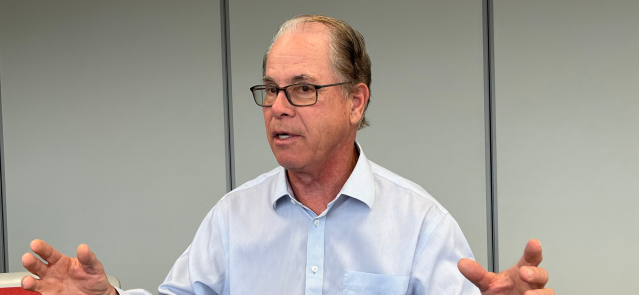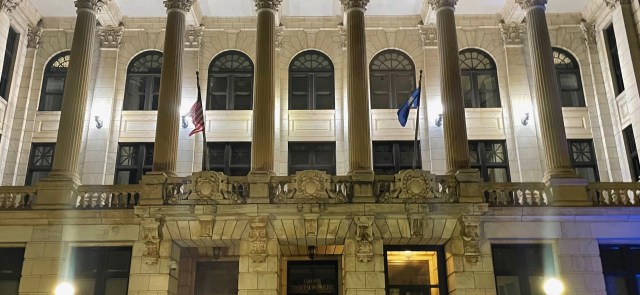General Services Department Commissioner Christi Branscom is stepping down after six years in the office that provides operational support services to all other departments and agencies in Tennessee state government.
Gov. Bill Lee has appointed Matt Van Epps, a consultant and member of the Tennessee Higher Education Commission, as her replacement.
“Christi has faithfully served state agencies and her fellow Tennesseans since day one of the Lee administration,” Lee said in a release. “During her tenure, she has led significant capital improvement projects, wisely stewarded taxpayer dollars by reducing the State’s real estate footprint, and secured the Department of General Services’ standing as a Top Tennessee Workplace for five consecutive years. Maria and I wish Christi continued success and pray God’s richest blessings over her in the days ahead.”
Her last day is Sept. 30.
Under her leadership, the General Services department and its divisions — Central Procurement Office, Document Solutions, Real Estate Asset Management (STREAM), and Vehicle & Asset Management — have received multiple national awards.
“I think she did an excellent job,” said Senate Speaker Randy McNally, R-Oak Ridge, noting Branscom “always kept us updated on things that were going on,” as State Building Commission members. That was especially important during the COVID-19 pandemic, which made it “much more difficult to predict cost increases because of inflation,” the speaker said.
Branscom joined Lee’s Cabinet when he took office in January 2019. She had been chief operating officer and general counsel at Partners Development in Knoxville. She is the founder of Grace Construction and previously served for more than five years as Knoxville Mayor Madeline Rogero’s deputy and Chief Operating Officer.
An early test for Branscom was the construction of a new inn at Fall Creek Falls State Park, a controversial project the Lee administration inherited from predecessor Bill Haslam’s time in office. In the summer of 2019, cost projections for the 95,000-square-foot facility near Spencer had skyrocketed by $11 million, or 37% over projections.
Branscom and state Environment and Conservation Commissioner David Salyers blamed the costs on difficulties in securing a builder for the remote Upper Cumberland Plateau park site amid a construction boom in Nashville and other areas. Branscom also said the state’s current estimating process relied heavily on the architect’s projections, which had proven to have a shaky foundation. Another issue was that Tennessee assumed an annual 4% inflation on projects, which was about half the actual going rate.
Going forward, she said the state would boost inflation rates to match reality. And instead of having the project architect provide estimates, the General Services Department would use professional “construction estimators” who regularly work in the market. Another remedy was to lengthening the state’s pre-planning process on projects to try to head off surprises to the bottom line.
Branscom’s department also began estimating costs based on the midpoint of construction. The shorter timetable allowed officials to more accurately predict how inflation, equipment, materials and labor costs will factor into the bottom line, Branscom told lawmakers last year. A large project with a $200 million budget could take up to five years to complete, she said, during which time economic conditions could change dramatically.
Senate Finance Chair Bo Watson, R-Hixson, earlier this year took aim at the Tennessee Higher Education Commission for “grossly” underestimating the costs of projects on the campuses of Austin Peay State University and Middle TEnnessee State University. Watson charged that the project was proposed “with an under-appreciation” for the true costs with the knowledge that the General Assembly would have to fund the increases to get them done. THEC’s new executive director, Steven Gentile, said he was working with the state architect and the General Services Department to improve budget forecasts.
Brancom oversaw the construction of a wastewater pipeline connecting the West Tennessee megasite with the Mississippi River, a project considered key to landing a massive investment from Ford Motor Co. The state considered a public-private partnerships or cooperating with nearby communities like Bartlett and Covington before ultimately deciding to go it alone.
When Lee finally won his showdown with fellow REpublicans in the Legislature over removing a bust of Nathan Beford Forrest from the state Capitol, Branscom’s agency was tasked with transferring the likeness of the Confederate cavalry general and early Ku Klux Klan leader to the Tennessee State Museum.
Citing unspecified “safety concerns,” General Services tried to block media access to the second floor of the Capitol while preparing the bust for transport. Reporters quickly suspected the administration was trying to prevent them from witnessing the moment the Forrest bust was hoisted out of its alcove. The House and Senate speakers, who have authority over the floor where the House and Senate chambers are located — and who opposed the move — intervened to prevent the media blackout.
One of the Lee administration’s signature capital projects is the construction of a $415 million Multi-Agency Law Enforcement Training Academy in Nashville. The 800-acre campus
will house the headquarters of the Correction and Safety departments, training facilities, classrooms, dormitories, and firing ranges. Branscom had to maneuver a backlash among local residents and lawmakers who worried about the plan to include the Tennessee Correction Academy in Tullahoma in the consolidated facility. The Coffee County facility employing more than 50 people was allowed to remain as a standalone entity when the State Building Commission approved to overall project in late 2022.
Another high-profile project involves the overhaul of the old Legislative Plaza and War Memorial Building. Lawmakers moved their operations to the Cordell Hull Building in 2018 following a $128 million overhaul. One of the selling points was that maintenance costs at the subterranean Legislative Plaza were becoming prohibitive, largely due to persistent water seepage problems and an antiquated HVAC system. The initial plan was for the offices and committee rooms to be demolished and turned into another level of underground parking. But the Lee administration changed course and Branscom in early 2022 presented a first detailed look at a proposal to spend $183 million to upgrade the old facility.
The plan involves an expanded military museum, a visitors’ center, a theater, and more conference rooms. The plaza above is to be made more park-like, while overdue repairs will be undertaken on the underground parking levels and the Motlow Tunnel connecting the facility to the Capitol and the Cordell Hull Building. Lawmakers had earlier approved $106 million in upgrades to the War Memorial Building, which are scheduled to be completed in 2025 — the 100th anniversary of its opening.
Branscom has also taken steps to sell off the Citizens Plaza and James K. Polk state office buildings. The latter was home to several state agencies and the Tennessee Performing Arts Center, which is getting a new facility in the new East Bank development alongside a covered NFL stadium.
Branscom was awarded the National Association of State Chief Administrators’ national leadership award in 2023. She had become the organization’s first female president in 2021.
The state earlier this year made the surprise announcement it would seek to buy and raze the last private building on Capitol Hill for $32 million. Capitol Towers, which was twice the size of any other residential building in Nashville when it opened in 1960, would be torn down to expand the green space around the Statehouse and the Cordell Hull legislative office building.
The state plan involves using $22 million in unused state bonds to purchase the building and $10 million in reserves from General Services’ revolving fund to buy out the remaining condominium owners.
Lawmakers in 2011 approved a bill authorizing the state to sell up to $273 million in bonds to help pay for various buildings around the state. A $34 million project for the Board of Regents never came to fruition, so the state is making use of those leftover bonds to fund the Capitol Towers purchase. No new appropriation was needed because the bonds are already authorized, and the debt service is accounted for in the state budget.





